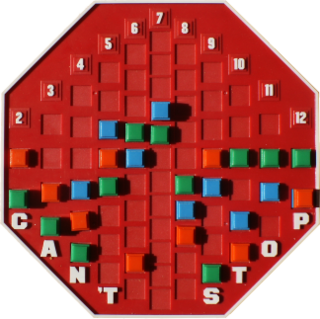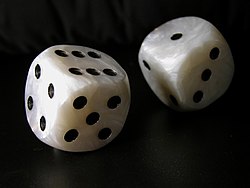
Backgammon is one of the oldest known board games. Its history can be traced back nearly 5,000 years to archaeological discoveries in Mesopotamia. It is a two-player game where each player has fifteen pieces that move between twenty-four triangles (points) according to the roll of two dice. The objective of the game is to be first to bear off, i.e. move all fifteen checkers off the board. Backgammon is a member of the tables family, one of the oldest classes of board games.

Craps is a dice game in which the players make wagers on the outcome of the roll, or a series of rolls, of a pair of dice. Players may wager money against each other or a bank. Because it requires little equipment, "street craps" can be played in informal settings. While shooting craps, players may use slang terminology to place bets and actions.

Ludo is a strategy board game for two to four players, in which the players race their four tokens from start to finish according to the rolls of a single die. Like other cross and circle games, Ludo is derived from the Indian game Pachisi, but simpler. The game and its variations are popular in many countries and under various names.

Can't Stop is a board game designed by Sid Sackson originally published by Parker Brothers in 1980; however, that edition has been long out of print in the United States. It was reprinted by Face 2 Face Games in 2007. An iOS version was developed by Playdek and released in 2012. The goal of the game is to "claim" three of the columns before any of the other players can. But the more that the player risks rolling the dice during a turn, the greater the risk of losing the advances made during that turn.

Parcheesi is a brand-name American adaptation of the Indian cross and circle board game Pachisi, published by Parker Brothers and Winning Moves.

Quarters is a drinking game which involves players bouncing an American quarter or similar-size coin off a table in an attempt to have the quarter land in a certain place, usually into a shotglass on that table. It is also played in South America, where it is called "monedita," Spanish for little coin.

Yahtzee is a dice game made by Milton Bradley, which was first marketed as Yatzie by the National Association Service of Toledo, Ohio, in the early 1940s. It was marketed under the name of Yahtzee by game entrepreneur Edwin S. Lowe in 1956. The game is a development of earlier dice games such as Poker Dice, Yacht and Generala. It is also similar to Yatzy, which is popular in Scandinavia.

Three Man (also referred to as Mr. Three or Hat Man) is a drinking game played with two dice. It can be played with at least three people but some consider it better with around five.

Mia is a simple dice game with a strong emphasis on bluffing and detecting bluff related to Liar's dice.
Pig is a simple dice game first described in print by John Scarne in 1945. As with many games of folk origin, Pig is played with many rule variations. Commercial variants of Pig include Pass the Pigs, Pig Dice, and Skunk. Pig is commonly used by mathematics teachers to teach probability concepts.
Liar's dice is a class of dice games for two or more players requiring the ability to deceive and to detect an opponent's deception.

Beer die is a table-based sport where opposing players sit or stand at opposite ends and throw a die over a certain height with the goal of either landing the die in their opponent's cup or having the die hit the table and bounce over the scoring area to the floor. The defending team attempts to catch the die one-handed after it hits the table, but before it touches a non-table surface. The game typically consists of two two-player teams with each of the four players having a designated cup on the table, but can also be played one-vs-one.

Acey-deucey is a variant of backgammon. Since World War I, it has been a favorite game of the United States Navy, Marine Corps, and Merchant Marine. Some evidence shows that it was played in the early 1900s aboard U.S. Navy ships. The game is believed to be rooted in the Middle East, Greece, or Turkey, where there were variants in which the game started with pieces off the board.
Dice chess can refer to a number of chess variants in which dice are used to alter gameplay; specifically that the moves available to each player are determined by rolling a pair of ordinary six-sided dice. There are many different variations of this form of dice chess. One of them is described here.
Mexico is an elimination-style dice game, in which several players agree to play a set number of rounds. After each round, one player is eliminated. When all players but one have been eliminated, the remaining player wins the game. Owing to its extremely simple play-structure, it is generally pursued as a method of gambling, whereby the final remaining player wins the amount of money wagered by each person who was eliminated in earlier rounds. A variant of the drinking game liar's dice known as Mexican or Mia uses similar dice rolls, but has very different game mechanics.
Chingona is a dice game played by two or more players, using four or five dice and a cup. It is usually played to decide who is to pay for the next round of drinks, but betting can also be involved.
Avalanche is a drinking game of chance which can be played with any number of players. Play passes counterclockwise around a circle. The current player adds some of his/her drink of an amount of his/her choosing to the "game glass." Adding only a little drink, especially to a fairly empty glass, is a small bet as this will be easy to drink if necessary. On the other hand, adding a large amount of drink, while risking a challenging "downing" task, also potentially inflicts that task on someone else.

Biscuit is a drinking game played with two dice.

The Mutschel is a traditional star-shaped bread from Reutlingen, Germany. The pastry, and the corresponding Mutscheltag, have probably existed since the 13th century. Mutscheln are roughly star-shaped and come in various sizes: usually approximately six inches in diameter, but bakeries often offer breads three or more feet in diameter. The most common Mutschel is made of wheat, yeast, a small amount of fat like lard or butter and eggs. They are sometimes made in sweet varieties.

Zombie Dice is a "press your luck" party dice game created by Steve Jackson Games and released in 2010. A digital app version of the game has also been released.














